Overview
 Americans are extremely displeased with Congress, and there are already some signs that this could take a toll on the Democrats in the 2010 midterm elections. Currently, 37% express a favorable opinion of Congress, while 52% hold an unfavorable view. Positive opinions of Congress have declined by 13 points since April and are now at one of their lowest points in more than two decades of Pew Research Center surveys.
Americans are extremely displeased with Congress, and there are already some signs that this could take a toll on the Democrats in the 2010 midterm elections. Currently, 37% express a favorable opinion of Congress, while 52% hold an unfavorable view. Positive opinions of Congress have declined by 13 points since April and are now at one of their lowest points in more than two decades of Pew Research Center surveys.
At the same time, intentions to vote Democratic in the next midterm election are markedly lower than they have been over the past four years. Voters are about evenly divided when asked how they would vote if the election for Congress were being held today: 45% say they would vote for a Democratic candidate in their district, or lean Democratic, while 44% say they would vote for a Republican or lean Republican. At about this point four years ago, Democrats led in the generic congressional ballot by 52% to 40% and went on to win a majority of the popular vote and regain control of Congress the following November.
 The new survey by the Pew Research Center for the People & the Press, conducted Aug. 20-27 in English and Spanish among 2,003 adults reached on landlines and cell phones, finds that the Democrats’ dimmer electoral prospects are more a matter of disillusionment with the party that controls Congress than a revival of the image of the Republican Party. Favorable ratings of the GOP remain quite low (40%), even as opinion of Democrats has soured; just 48% say they have a favorable opinion of the Democratic Party, down 11 points since April.
The new survey by the Pew Research Center for the People & the Press, conducted Aug. 20-27 in English and Spanish among 2,003 adults reached on landlines and cell phones, finds that the Democrats’ dimmer electoral prospects are more a matter of disillusionment with the party that controls Congress than a revival of the image of the Republican Party. Favorable ratings of the GOP remain quite low (40%), even as opinion of Democrats has soured; just 48% say they have a favorable opinion of the Democratic Party, down 11 points since April.
Most of the shift in voting intentions since the 2006 election cycle has occurred among political independents. Independent voters backed Democrats by a wide margin in the previous midterm (11 points on the eve of the election), but currently say they support the GOP candidate in their district by 43% to 38%.
 Independents’ views of Congress shifted more dramatically in recent months than have opinions among Republicans or Democrats. Notably, independent voters who express an unfavorable view of Congress, say they would back the GOP candidate over the Democrat by a whopping 51% to 31% margin, while the smaller proportion of independent voters who have a positive view of Congress say they intend to vote for the Democrat, by 55% to 29%.
Independents’ views of Congress shifted more dramatically in recent months than have opinions among Republicans or Democrats. Notably, independent voters who express an unfavorable view of Congress, say they would back the GOP candidate over the Democrat by a whopping 51% to 31% margin, while the smaller proportion of independent voters who have a positive view of Congress say they intend to vote for the Democrat, by 55% to 29%.
A separate national survey, conducted Aug. 27-30 among 1,005 adults, finds that the Democratic Party continues to hold substantial advantages over the GOP on nearly all issues and leadership traits. Yet since last year the Democrats’ leads on most issues have narrowed, including the economy and taxes. In addition, the two parties currently run about even on which can do a better job of reducing the federal budget deficit; in the fall of 2006, the Democrats led by a wide margin on the deficit.
The Democrats continue to be widely viewed as the party more associated with honest and ethical governance, concern with the needs of average Americans, and having better candidates for office. However, nearly as many say the Republican Party as (34%) as Democratic Party (38%) can manage the federal government; two years ago, the Democrats led by 12 points (44% to 32%) as better able to manage the government.
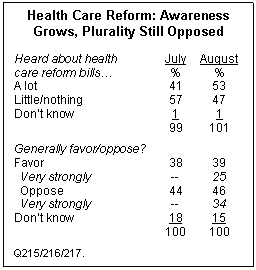 Opinions about health care reform may well be contributing to public discontent with Congress. By a 46% to 39% margin, more Americans generally oppose than favor the health care proposals being considered in Congress, which is little changed from July (44% oppose, 38% favor).
Opinions about health care reform may well be contributing to public discontent with Congress. By a 46% to 39% margin, more Americans generally oppose than favor the health care proposals being considered in Congress, which is little changed from July (44% oppose, 38% favor).
An increasing proportion of Americans have heard “a lot” about health care bills in Congress; 53% say that now, up from 41% in July. And as was the case then, most of those who have heard a lot about the legislation are generally opposed to these proposals (by 55% to 38%) while those who have heard less about the proposals are evenly divided (41% favor, 36% oppose, 23% no opinion).
There is more intense opposition than support for health care reform legislation: 34% say they very strongly oppose the proposals while 25% favor these proposals very strongly. Opinion about health care reform also continues to be highly partisan. More than seven-in-ten conservative Republicans (72%) say they very strongly oppose the health care reform legislation being discussed in Congress. Strong support is concentrated among liberal Democrats; still only about half of this group (52%) says they very strongly favor the bills.
For all the public’s reservations about health care reform, however, Barack Obama continues to enjoy the confidence of a majority of the public with regard to this issue. More than half (56%) say they have a great deal (26%) or a fair amount of confidence (30%) in Obama to do the right thing in dealing with health care reform. That compares with 45% who have at least a fair amount of confidence in Democratic leaders in Congress and 39% who have confidence in GOP congressional leaders.
Health Care Up, Economy Down as Top National Problem
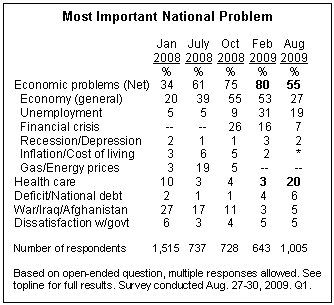 The economy remains the most frequently mentioned problem facing the nation, but an increasing proportion of Americans cite health care. Currently, 55% mention the economy in general or one of several specific economic problems, such as unemployment or the financial crisis. In February, 80% mentioned the economy, the highest percentage in more than 20 years of Pew’s surveys.
The economy remains the most frequently mentioned problem facing the nation, but an increasing proportion of Americans cite health care. Currently, 55% mention the economy in general or one of several specific economic problems, such as unemployment or the financial crisis. In February, 80% mentioned the economy, the highest percentage in more than 20 years of Pew’s surveys.
Meanwhile, mentions of health care as the top national problem have risen from just 3% in February to 20% today. The last time health care was cited this often was June 1994, during the congressional debate over health care reform in Bill Clinton’s first term. There is little difference in the percentage of Democrats (26%) and Republicans (20%) citing health care as an important national problem. 
The federal budget deficit and the national debt, the subject of much media attention recently, were mentioned by 6%, essentially unchanged from February when 4% cited the debt or deficit.
Other issues – including the wars in Iraq and Afghanistan – are far less likely to be mentioned today than in the past. Iraq and Afghanistan were cited by 5%, down from 17% about a year ago and from a high of 42% in January 2007. Collectively, international issues, including both wars, were mentioned by 10%.
Race for Congress Tied
When asked to look ahead to the 2010 races for Congress, voters divide almost evenly between the parties. The sizable advantage enjoyed by the Democratic Party in the past two election cycles is gone, at least for now. As in previous years, both parties command nearly unanimous support from their own ranks. But the Democratic edge among independent voters, critical to their large electoral gains in 2006 and 2008, has vanished. Republicans have gained 10 points since November 2006, on the eve of the midterms (from 33% to 43%).
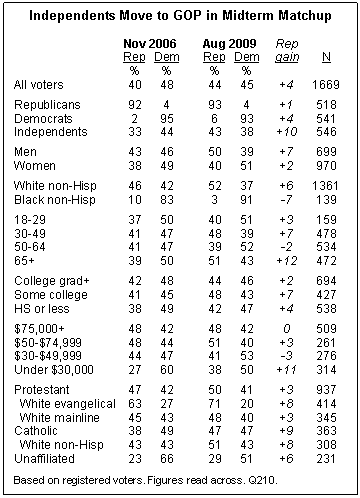 Republicans now lead among white non-Hispanic voters (by 15 points), men (11 points) and voters 65 and older (by eight points). In November 2006, Democrats ran about even among whites and men, and led by 11 points among voters 65 and older. In addition, Republicans now lead by eight points among white non-Hispanic Catholics, whose vote preferences were evenly divided at the end of the last midterm campaign.
Republicans now lead among white non-Hispanic voters (by 15 points), men (11 points) and voters 65 and older (by eight points). In November 2006, Democrats ran about even among whites and men, and led by 11 points among voters 65 and older. In addition, Republicans now lead by eight points among white non-Hispanic Catholics, whose vote preferences were evenly divided at the end of the last midterm campaign.
Democrats have a huge lead
among African Americans, and more modest advantages among women (51%-40%), low-income voters (50%-38%); however, Republicans have gained 11 points since 2006 among the latter group. Democrats continue to hold an advantage among voters unaffiliated with a religion, but their margin has declined.
Attitudes about health care reform are closely related to vote intentions. Voters who favor the reform proposals currently being discussed support Democratic candidates by a margin of 81% to 12%. Among the larger proportion that opposes the reform proposals, 72% support Republican candidates for Congress compared with 18% who back Democratic candidates.
Favorability of Congress Sinks
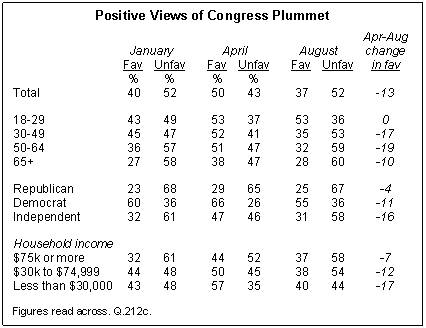 Public evaluations of Congress are now at an all-time low, with 37% saying they have a favorable impression of Congress. That represents a sharp downturn from April (50%), though is only slightly lower than in January (40%).
Public evaluations of Congress are now at an all-time low, with 37% saying they have a favorable impression of Congress. That represents a sharp downturn from April (50%), though is only slightly lower than in January (40%).
Congress’ current favorability rating is lower than at several key points over the past two decades, including just prior to the 2006 midterm (41% favorable), during the impeachment trial of former President Clinton (48% in January 1999), and during the government shutdown in late 1995 (42% in January 1996).
Congress’s favorability now stands at 55% among Democrats, down from 66% in April and 60% in January. Among independents, positive ratings have fallen 16 points since April, from 47% to 31%; in January, 32% of independents had a positive view of Congress. Opinions of Congress among Republicans remain overwhelmingly negative; currently, 25% say they have a favorable opinion while 67% have a negative view.
Young people continue to be the only age group in which a majority expresses a favorable opinion of Congress; 53% currently do so, unchanged from April. By contrast, positive views have declined among all other age groups.
Party Images and Issues
The Democratic Party’s overall image has slipped since earlier this year, but the party has retained advantages over the Republicans on many traits and issues. Compared with the fall of 2007, the Democrats continue to have double-digit leads over the GOP in key areas such as concern about the disadvantaged, empathy, ability to bring about needed change, the quality of its candidates, and ethics and honesty.
However, the party has lost its advantage over the Republican Party as better able to manage the federal government. On the eve of the 2006 elections, the public preferred the Democrats by 10 points (44% to 34%) as the party better able to manage the government. This lead swelled to 16 points early in 2007. Today the Democrats hold a statistically insignificant 38% to 34% advantage on this question. Independents – who in recent years had viewed the Democrats as better managers – are now divided (32% Democrat vs. 29% Republican).
But the Democrats remain solidly ahead in other areas. By 51% to 27% they are viewed as the party “more concerned about people like me,” an advantage that has changed little over the past five years. Similarly, Democrats, more than Republicans, are still seen as best able to bring about the kinds of changes the country needs (47% to 25%). And the party is still seen as governing in a more ethical and honest way (42% vs. 26%), an advantage that has not changed in nearly three years.
 Democrats continue to be preferred on most specific issues, but their advantages on many have narrowed. On two issues holding center stage today – health care reform and the economy – the Democratic Party retains an advantage, but one that is smaller than in 2008. The public says the Democratic Party can do a better job of reforming the U.S. health care system, by 46% to 27%. But that 19-point lead is down from 30 points in early 2008. Similarly, the Democrats outpace the Republicans by 10 points on the economy (42% to 32%), but their advantage in 2008 was 19 points.
Democrats continue to be preferred on most specific issues, but their advantages on many have narrowed. On two issues holding center stage today – health care reform and the economy – the Democratic Party retains an advantage, but one that is smaller than in 2008. The public says the Democratic Party can do a better job of reforming the U.S. health care system, by 46% to 27%. But that 19-point lead is down from 30 points in early 2008. Similarly, the Democrats outpace the Republicans by 10 points on the economy (42% to 32%), but their advantage in 2008 was 19 points.
Moreover, on both the budget deficit and taxes, about equal numbers of Americans now see each party as best able to handle the issue. On the budget deficit, this represents a sharp drop for the Democrats. In September 2006, the Democrats led the Republicans by 47% to 27%. Now, 36% favor the Democrats and 35% the Republicans. On taxes, the Democratic Party led the GOP by eight points in 2006 and 12 points two years later; today, as many say the Republican Party (38%) as the Democratic Party (37%) can do a better job dealing with taxes.
The Democratic Party has lost little ground as the party better able to improve education (47% favor the Democrats, 22% the Republicans) or abortion (41% to 33%). And on foreign policy, the Democrats’ advantage has increased from five points in February 2008 to 13 points currently. Since then the proportion saying the Republicans can do a better job on foreign policy has declined from 40% to 31%, while the percentage favoring the Democrats is largely unchanged.
Looking across the 11 policy issues included in the current 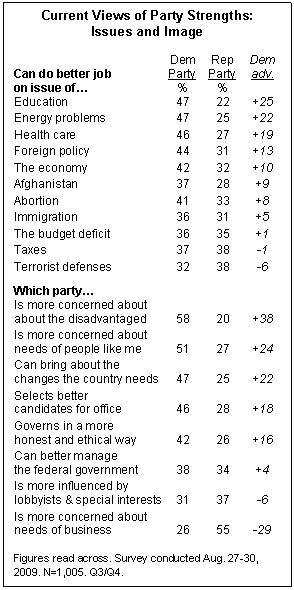 survey, the Democratic Party holds significant leads on seven, including a 37% to 28% advantage as the party better able to make wise decisions about what to do in Afghanistan. On three other issues – the budget deficit, taxes and immigration – the two parties run about even, while the Republican Party holds a slight edge on only one issue – dealing with terrorist threats at home.
survey, the Democratic Party holds significant leads on seven, including a 37% to 28% advantage as the party better able to make wise decisions about what to do in Afghanistan. On three other issues – the budget deficit, taxes and immigration – the two parties run about even, while the Republican Party holds a slight edge on only one issue – dealing with terrorist threats at home.
Similarly, the Democrats are viewed positively on most leadership dimensions, with the notable exception of managing the government. Slightly more people see the GOP (37%), rather than the Democratic Party (31%), as more influenced by lobbyists and special interests. The perception that the Republicans are more influenced by lobbyists is somewhat less widespread than during the 2006 campaign, when 41% said the Republican Party was more influenced by special interests and lobbyists, compared with 27% who said the same about the Democratic Party.
The Republican Party continues to be widely viewed as the party concerned with the needs and interests of business; currently, 55% view the Republicans as concerned with the needs of business compared with 26% for the Democrats. These opinions have changed little since the 1990s.
Health Care: More Tuning In
Even with Congress on its August recess, the public’s attention to the health care debate has grown substantially since July. When asked about the bills in Congress to overhaul the health care system, more than half (53%) say they have heard a lot about the proposals, 40% have heard a little, and only 7% have heard nothing at all. In July, somewhat fewer (41%) reported hearing a lot about the health care bills. In addition, since late July, the health care debate in Washington has been the most closely followed story on Pew Research’s weekly News Interest Index. (See “Health Care Still the Summer’s Dominant Story,” Aug. 26, 2009.)
 Republicans continue to be more attentive to the health care debate than Democrats but the gap has narrowed over the past month; 58% of Republicans have heard a lot about the bills compared with 50% of Democrats. In July, 52% of Republicans and only 38% of Democrats had heard a lot. Independents continue to track more closely with Democrats; 51% have heard a lot, up 12 percentage points since July.
Republicans continue to be more attentive to the health care debate than Democrats but the gap has narrowed over the past month; 58% of Republicans have heard a lot about the bills compared with 50% of Democrats. In July, 52% of Republicans and only 38% of Democrats had heard a lot. Independents continue to track more closely with Democrats; 51% have heard a lot, up 12 percentage points since July.
Compared with July, more people across all age groups report hearing a lot about health care legislation in Congress, but wide age differences remain. Just 36% of those younger
than 30 say they have heard a lot about health care; by comparison, majorities of those in older age groups say they are hearing a lot about the health care bills in Congress. Still, the percentage of those younger than 30 hearing a great deal has increased by 14 points since July.
Health Care Opinions Largely Unchanged
 The overall balance of opinion about the health care reform bills before Congress has not changed since July. More Americans say they generally oppose the proposals than generally favor them (by 46% to 39%). In July, 44% opposed and 38% favored the bills.
The overall balance of opinion about the health care reform bills before Congress has not changed since July. More Americans say they generally oppose the proposals than generally favor them (by 46% to 39%). In July, 44% opposed and 38% favored the bills.
More than three-quarters of Republicans (78%) of Republicans, including 83% of conservative Republicans, oppose the bills to overhaul health care. By contrast, 64% of Democrats favor the bills, including three-fourths (75%) of liberal Democrats. As in July, more independents oppose the bills than favor them (48% vs. 37%).
The balance of opinion among most demographic groups also has not changed much since July. Nearly twice as many non-Hispanic whites oppose health care legislation (56%) as favor it (29%). African Americans support the bills by an even greater margin than in July (71% to 15%). Meanwhile, opposition to health care legislation among those 65 and older, already widespread, has ticked up since July; 54% now oppose health care legislation compared with 48% last month.
 The current poll also finds that there is greater intensity in opinion among opponents of the bills than among supporters. About a third (34%) of Americans oppose the bills very strongly while 12% oppose them not so strongly. By comparison, a quarter (25%) favors health care proposals in Congress very strongly and 13% not so strongly.
The current poll also finds that there is greater intensity in opinion among opponents of the bills than among supporters. About a third (34%) of Americans oppose the bills very strongly while 12% oppose them not so strongly. By comparison, a quarter (25%) favors health care proposals in Congress very strongly and 13% not so strongly.
Fully 72% of conservative Republicans say they very strongly oppose health care legislation – far more than any other political group. Intense support for the health care bills among liberal Democrats is less widespread: about half of liberal Democrats (52%) say they support this legislation very strongly. About a third of independents (34%) oppose health care legislation very strongly, while just 21% support the bills very strongly.
More Aware, More Opposed
 As in July, opposition to health care legislation is greater among those who have heard a lot about the bills. More than half (55%) of those who have heard a lot about the bills being discussed in Congress generally oppose them while 38% favor them. Opinion is divided among those who have heard only a little or nothing at all (41% favor, 36% oppose).
As in July, opposition to health care legislation is greater among those who have heard a lot about the bills. More than half (55%) of those who have heard a lot about the bills being discussed in Congress generally oppose them while 38% favor them. Opinion is divided among those who have heard only a little or nothing at all (41% favor, 36% oppose).
Nearly nine-in-ten Republicans (87%) who have heard a lot about the health care bills oppose them – and 78% say they oppose them very strongly. Among Republicans who have heard less about the legislation, 67% are opposed and fewer than half (43%) are very strongly opposed.
While independents who have heard a lot about health care reform legislation oppose them by a wide margin (61% to 33%), those who have heard a little or nothing are divided (41% favor, 35% oppose).
Among Democrats, 71% of those who have heard a lot about the health care bills favor them, including 55% who favor them strongly. Somewhat fewer (59%) of those who have heard a little or nothing about the legislation favor it, and just 34% favor it very strongly.
Gauging Potential Impact of Reform
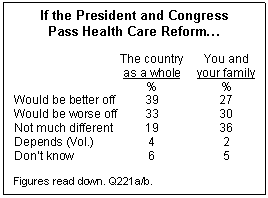 Substantially more people are optimistic that health care reform would benefit the country than say it would help them. A plurality (39%) think reform would make the country as a whole better off, 33% say the country would be worse off, while 19% say it would make no difference. By comparison, 27% believe health care reform would make them and their families better off, 30% believe they would be worse off personally, while 36% think it would not make a difference to their situation.
Substantially more people are optimistic that health care reform would benefit the country than say it would help them. A plurality (39%) think reform would make the country as a whole better off, 33% say the country would be worse off, while 19% say it would make no difference. By comparison, 27% believe health care reform would make them and their families better off, 30% believe they would be worse off personally, while 36% think it would not make a difference to their situation.
The gap in people’s perceptions of how health care reform would affect the country – and themselves – is greatest among those  who support the the legislation. Supporters of the legislation are far more optimistic about it benefiting the country as a whole (77%) than benefitting themselves (54%). By contrast, those who oppose the bills before Congress are about equally likely to say the legislation will make the country (64%) and themselves worse off (60%).
who support the the legislation. Supporters of the legislation are far more optimistic about it benefiting the country as a whole (77%) than benefitting themselves (54%). By contrast, those who oppose the bills before Congress are about equally likely to say the legislation will make the country (64%) and themselves worse off (60%).
This pattern is seen in the breakdown by party as well. Republicans see health care as bad for both the country (61%) and themselves (57%). Meanwhile, 62% of Democrats see reform as good for the country, while 44% believe they themselves will benefit.
People who are younger than 30 are more likely than older people to express positive views about the bills’ impact on the nation and them personally. Nearly half (46%) of young people say the country will be better off, while 37% say they will be better off – the highest percentages for any age group.
Most Are Confident in Obama on Health Care
 Overall, 55% of Americans say they have either a great deal (26%) or a fair amount (30%) of confidence in Barack Obama when it comes to dealing with health care reform. This includes 83% of Democrats, 54% of independents, and 24% of Republicans.
Overall, 55% of Americans say they have either a great deal (26%) or a fair amount (30%) of confidence in Barack Obama when it comes to dealing with health care reform. This includes 83% of Democrats, 54% of independents, and 24% of Republicans.
Smaller percentages express the same level of confidence in either the Democratic leaders in Congress (45%) or Republican leaders in Congress (40%). Independents make little distinction between the congressional parties, with just 39% expressing confidence in Congressional Democrats, and 36% in Congressional Republicans.


